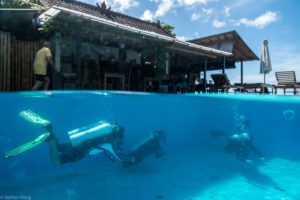We’re nearing the end of our tech-diving ABCs series with the letters U through W: U for understanding your limits and W for wetsuits vs. drysuits. Check out the ABCDs, E through H, I through L, M through P and Q through T as well.
U is for Understanding your Limits
Technical diving is about expanding your limits underwater. In fact, technical diving for recreational purposes as a subdiscipline (next to sport, commercial and research diving) developed in response to the limits imposed by sport diving. In order to widen access to diving as a hobby, newly created training agencies set depth and time limits to keep divers relatively safe. However, while many divers were happy to explore within those limits, others sought to go further. Consequently, technical diving standards developed alongside tech-diving training agencies.
Technical diving does exceed depth, time and environmental limits, but divers still learn incrementally. As they progress through levels of training, they expand their own comfort zone step by step. Understanding your own limits — in relation to equipment, gases, decompression time, dive skills, knowledge etc. — is a key part of any technical course and one of the main drivers of diver safety.
V is for Valve Drills

Valve or shutdown drills are another key part of technical-diving training. Being able to perform them reliably and fast allows divers to isolate leaks and preserve as much as possible of their gas.
The drills are arguably easier in sidemount configuration, as tank valves are within the diver’s field of vision. This makes it easier to identify the source of a problem. However, when moving on to technical sidemount, divers may find their front somewhat cluttered as tank rigging and equipment familiarity become more important. Successfully repeating valve drills during their course and afterward helps them identify and shut down the current valve.
In backmount configuration, a diver’s ability to perform reliable and speedy shutdown drills is even more important as leaks are happening where a diver cannot see them. Of course, a teammate can help identify the source of the problem, but technical divers learn to be self-sufficient. Thus, being able to reach valves and turn them in the correct direction to stop a leak is vital.
Divers often practice this in two stages during training courses: First, divers start with systematic, repetitive shutdown cycles that train muscle memory. Instructors often refer to stage two as a BOOM drill. In this, the instructor simulates a leak behind the diver who must now go through a series of steps to identify and isolate the leak, both alone and together with a teammate. The aim is to efficiently contain the leak, preserve access to as much gas as possible and start a timely ascent.
Both are much easier if divers initially practice on land. Successful performance depends on repetition, both during the course and afterward.
W is for wetsuits vs. drysuits

Technical dives take divers deeper and last longer than the average recreational dive, so exposure protection is crucial. It’s about more than just comfort: on- and off-gassing are related to circulation which, in turn, is related to body temperature.
During the dive’s decompression phase, divers are generally at rest and therefore more prone to hypothermia. Keeping the body’s temperature normal is key to efficient off-gassing and as movement is limited, the diver’s exposure suit is doing that work. Tropical environments really are the only place where wetsuits are warm enough for tech divers.
However, even in the tropics many techies opt for drysuits as it’s simply the equipment they are used to diving. So-called tropical drysuits limit sweating and overheating before the dive while still allowing the diver to layer undergarments depending on the expected water temperature. Another argument for a full wetsuit or a drysuit is that divers will encounter thermoclines at greater depths.
In overhead environments, protection from scratches and cuts becomes an issue, meaning that even if temperatures allow for a short suit, it’s simply not the best choice. Stay tuned for the final installment of our series, where we’ll cover X, Y and Z.

